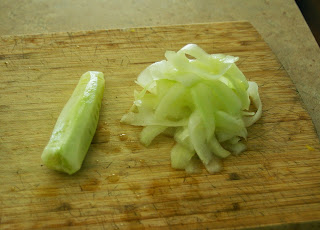If any of that resonated with you, what I'm about to describe will either be exciting or exacerbate the issue: you know those knit-mesh bags that onions, clementines and other produce are often packaged in? A few minutes of crocheting (even if, like me, you're not much of a crocheter) turns them into awesome, reusable produce bags. You can wash produce right in these bags and then hang the whole thing to dry. They are extremely light and compact but strong and adapt to hold a variety of shapes and quantities.
- one mesh bag (see below for details about different kinds of mesh)
- ~8 yds strong twine (I use #15 or #18 nylon mason's twine)
- crochet hook, size H-J
Ingredients:
Types of Mesh
There's a couple of different types of mesh that these bags are made of, and each type has its advantages and disadvantages. These are the three main types you will see:| Knitted Mesh | |
| This is easily my favorite, as it's the most flexible and adaptable. However, it also requires the most careful construction; the loops that make up the top of the bag can come undone under stress, so it's important to crochet a few rows down from the edge to avoid this. | |
| Woven Mesh | |
| Harder to come apart than knitted mesh, but much more stiff. Woven mesh will still fold up small, but does not adapt to the shape of its contents as well as knitted mesh or diamond fused mesh. | |
| Fused Mesh | |
| This type completely avoids the problem of things coming apart, since the whole thing is one piece, but it's also more rigid than the other types of mesh. There are two kinds here: square fused mesh and diamond fused mesh. Diamond fused mesh has many of the same properties as knitted mesh, while square fused mesh is much like woven mesh. |
Pattern
Note: Click any stitch name to see an instructional video for it. These are videos I found already on YouTube, rather than ones I made.- Double Crochet three or four rows down from each opening in the top row.
- Join with a slip stitch when you get all the way around.
- On the next round, chain two stitches, and do a single crochet into every other stitch all the way around. That's (ch 2, sc) all around for those of you who speak crochet.
- Join with a slip stitch again, then cut your twine, draw through the loop and weave in the end.
- Next, add a drawstring. Cut a piece of twine about two feet long and thread it through the gaps made by the skipped stitches.
Update (9/6/14): due to a single quotation mark out of place in my coding, the juicy part of step 3 was not visible until now. Apologies to anyone confused.
Hooray, it's a bag!










